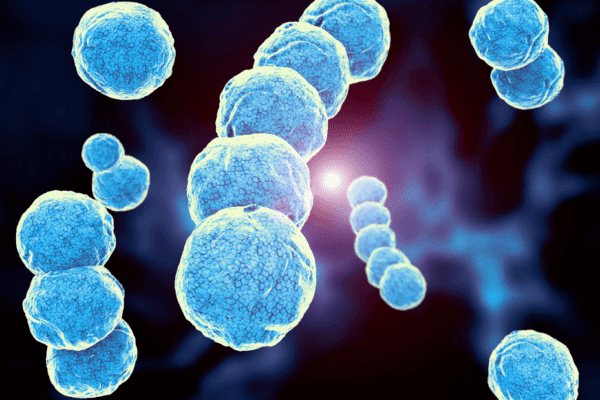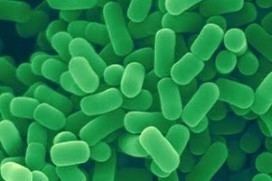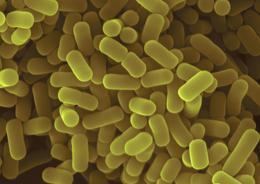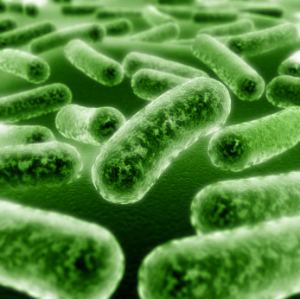Domain Bacteria Order Lactobacillales Genus Lactobacillus Rank Species | Phylum Firmicutes Family Lactobacillaceae Scientific name Lactobacillus plantarum Higher classification Lactobacillus | |
 | ||
Similar Lactobacillus, Bacteria, Lactobacillus casei, Lactobacillus rhamnosus, Bifidobacterium longum | ||
Lactobacillus plantarum is a widespread member of the genus Lactobacillus, commonly found in many fermented food products as well as anaerobic plant matter. It is also present in saliva (from which it was first isolated). It has the ability to liquefy gelatin. L. plantarum has one of the largest genomes known among the lactic acid bacteria and is a very flexible and versatile species.
Contents
- Metabolism
- Silage
- Food products
- Therapeutics
- Antimicrobial property
- Activity against AIDS defining illnesses
- Biochemistry
- References

Metabolism

L. plantarum is a Gram-positive-aerotolerant bacteria that grows at 15 °C (59 °F) but not at 45 °C (113 °F), and produces both isomers of lactic acid (D and L). This species and related lactobacilli are unusual in that they can respire oxygen but have no respiratory chain or cytochromes — the consumed oxygen ultimately ends up as hydrogen peroxide. The peroxide, it is presumed, acts as a weapon to exclude competing bacteria from the food source. In place of the protective enzyme superoxide dismutase present in almost all other oxygen-tolerant cells, this organism accumulates millimolar quantities of manganese polyphosphate. Manganese is also used by L. plantarum in a pseudo-catalase to lower reactive oxygen levels. Because the chemistry by which manganese complexes protect the cells from oxygen damage is subverted by iron, these cells contain virtually no iron atoms; in contrast, a cell of Escherichia coli of comparable volume contains over one-million iron atoms. Because of this, L. plantarum cannot be used to create active enzymes that require a heme complex such as true catalases.
Lactobacillus plantarum, like many lactobacillus species, can be cultured using MRS media.
Silage

Lactobacillus plantarum is the most common bacterium used in silage inoculants. During the anaerobic conditions of ensilage, these organisms quickly dominate the microbial population, and, within 48 hours, they begin to produce lactic and acetic acids via the Embden-Meyerhof Pathway, further diminishing their competition. Under these conditions, L. plantarum strains producing high levels of heterologous proteins have been found to remain highly competitive. This quality could allow this species to be utilized as an effective biological pretreatment for lignocellulosic biomass.
Food products

L. plantarum is commonly found in many fermented food products including sauerkraut, pickles, brined olives, Korean kimchi, Nigerian Ogi, sourdough, and other fermented plant material, and also some cheeses, fermented sausages, and stockfish. The high levels of this organism in food also makes it an ideal candidate for the development of probiotics. In a 2008 study by Juana Frias et al., L. plantarum was applied to reduce the allergenicity of soy flour. The result showed that, compared to other microbes, L. plantarum-fermented soy flour showed the highest reduction in IgE immunoreactivity (96–99%), depending upon the sensitivity of the plasma used. L. plantarum is also found in dadiah, a traditional fermented buffalo milk of the Minangkabau tribe, Indonesia.
Therapeutics

L. plantarum has significant antioxidant activities and also helps to maintain the intestinal permeability. It is able to suppress the growth of gas producing bacterium in the intestines and may have benefit in some patients who suffer from IBS. Lactobacillus plantarum has been found in experiments to increase hippocampal brain derived neurotrophic factor which means L. plantarum may have a beneficial role in the treatment of depression. The ability of L. plantarum to survive in the human gastro-intestinal tract makes it a possible in vivo delivery vehicle for therapeutic compounds or proteins.
L. plantarum is a constituent in VSL#3. This proprietary, standardized, formulation of live bacteria may be used in combination with conventional therapies to treat ulcerative colitis, and requires a prescription.
Antimicrobial property
The ability of L. plantarum to produce antimicrobial substances helps them survive in the gastro-intestinal tract of humans. The antimicrobial substances produced have shown significant effect on Gram-positive and Gram-negative bacteria.
Activity against AIDS-defining illnesses
As a result of initial HIV infection, the gut has been found to be a prime center of immune activity. The immune systems' Paneth cells of the gut attack HIV by producing IL-1β, which results in massive collateral damage—sloughing of tight intestinal lining (witnessed as severe diarrhea). This destruction of the gut lining allows other pathogens, e.g. Cryptococcus species to invade, resulting in an AIDS defining illness such as Cryptococcosis (this pathogen represents 60%-70% of all AIDS defining cases, but not necessarily only the gut). L. plantarum is able to reduce (destroy) IL-1β, resolving inflammation, and accelerating gut repair within hours.
Biochemistry
The entire genome has recently been sequenced, and promoter libraries have been developed for both conditional and constitutive gene expression, adding to the utility of L. plantarum. It is also commonly employed as the indicative organism in niacin bioassay experiments, in particular, AOAC International Official Method 944.13, as it is a niacin auxotroph.
